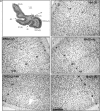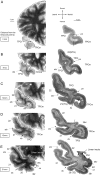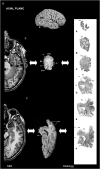The human parahippocampal region: I. Temporal pole cytoarchitectonic and MRI correlation
- PMID: 20064939
- PMCID: PMC2923216
- DOI: 10.1093/cercor/bhp289
The human parahippocampal region: I. Temporal pole cytoarchitectonic and MRI correlation
Abstract
The temporal pole (TP) is the rostralmost portion of the human temporal lobe. Characteristically, it is only present in human and nonhuman primates. TP has been implicated in different cognitive functions such as emotion, attention, behavior, and memory, based on functional studies performed in healthy controls and patients with neurodegenerative diseases through its anatomical connections (amygdala, pulvinar, orbitofrontal cortex). TP was originally described as a single uniform area by Brodmann area 38, and von Economo (area TG of von Economo and Koskinas), and little information on its cytoarchitectonics is known in humans. We hypothesize that 1) TP is not a homogenous area and we aim first at fixating the precise extent and limits of temporopolar cortex (TPC) with adjacent fields and 2) its structure can be correlated with structural magnetic resonance images. We describe here the macroscopic characteristics and cytoarchitecture as two subfields, a medial and a lateral area, that constitute TPC also noticeable in 2D and 3D reconstructions. Our findings suggest that the human TP is a heterogeneous region formed exclusively by TPC for about 7 mm of the temporal tip, and that becomes progressively restricted to the medial and ventral sides of the TP. This cortical area presents topographical and structural features in common with nonhuman primates, which suggests an evolutionary development in human species.
Figures









References
-
- Arnold SE, Hyman BT, Flory J, Damasio AR, Van Hoesen GW. The topographical and neuroanatomical distribution of neurofibrillary tangles and neuritic plaques in the cerebral cortex of patients with Alzheimer's disease. Cereb Cortex. 1991;1:103–116. - PubMed
-
- Arnold SE, Hyman BT, Van Hoesen GW. Neuropathologic changes of the temporal pole in Alzheimer's disease and Pick's disease. Arch Neurol. 1994;51:145–150. - PubMed
-
- Bailey P, Bonin von G. The isocortex of man. Urbana, (IL): University of Illinois Press; 1951.
-
- Barbeau E, Sontheimer A, Joubert S, Didic M, Felician O, Tramoni E, Grimault S, Ceccaldi M, Poncet M. The human perirhinal cortex. Rev Neurol. 2004;160:401–411. - PubMed
-
- Baron JC, Chételat G, Desgranges B, Perchey G, Landeau B, de la Sayette V, Eustache F. In vivo mapping of gray matter loss with voxel-based morphometry in mild Alzheimer's disease. NeuroImage. 2001;14:298–309. - PubMed
Publication types
MeSH terms
LinkOut - more resources
Full Text Sources
Medical
Miscellaneous

